Chinese hamsters stand out from other hamster breeds because of their unusually long tail. They’re not technically dwarf hamsters, but they’re still incredibly small. Chinese hamsters are one of the 5 hamster breeds that you can choose from when getting one of these little critters as a pet. All the hamster breeds have their own unique personalities, characteristics, and traits. Knowing the difference between the breeds is essential for making a choice of which breed fits you best.
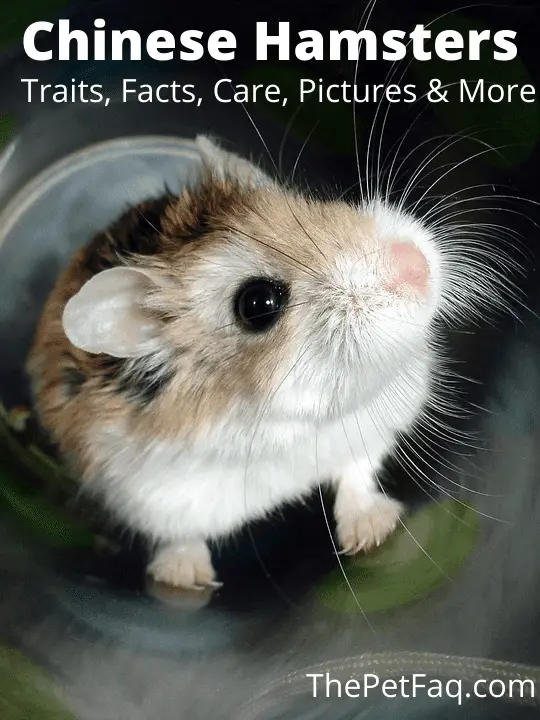
Today, we’re putting the Chinese hamster in the spotlight. We’ll go over the origins of the breed, their temperament, how to care for them and share some interesting facts about this adorable critter. Of course, the article will be accompanied by plenty of pictures for your viewing pleasure. Let’s dig in!
Chinese Hamster Fact Sheet
| Name | Chinese Hamster |
| Length | 3 to 5 inches |
| Weight | 1 to 2 ounces |
| Experience required | Beginner-friendly |
| Lifespan | 2 to 3 years |
| Temperament | Good-natured, shy, can be territorial |
| Colors | Standard, Dominant Spot, Black-eyed White |
| Alone or in pairs? | Alone, except for very rare exceptions |
| Price | $30 to $40 from a breeder |
What is a Chinese Hamster?
The Chinese Hamster, also known as the Chinese striped hamster, is a tiny hamster native to the deserts of Northern China and Mongolia. While they are not actually dwarf hamsters they’re often referred to as such because of their small size.
Most hamster breeds have a short, stubby tail, but not the Chinese. The Chinese stands out from other breeds due to their incredibly long tail for a hamster.
In the past, these little rodents were often used as lab animals. However, this is no longer the case and now they’re mainly kept as pets.
Appearance of the Chinese hamster
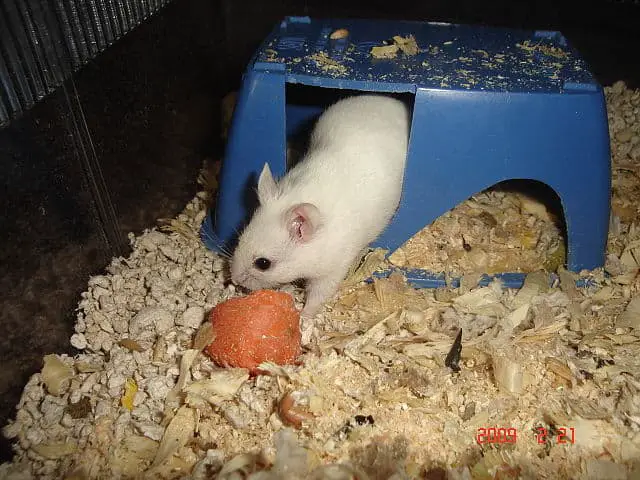
Besides its long tail, the Chinese hamster is characterized by a short, smooth, coat with a black stripe running down its spine. Their coats are often brown and their underside is white. However, there are 3 different types of colors that these hamsters can have:
- Normal. This is the coat that they have in the wild: brown with a dark dorsal stripe and a white underside. It’s by far the most common color.
- Dominant spot. These hamsters have a white coat with a contrasting dark dorsal stripe. They also have varying amounts of dark pigment on the rest of their coat.
- Black-eyed White. This is a very new mutation and the genetics behind it are not very well understood yet. To find a hamster with this color for sale you’ll have to find a specialized breeder because they’re not available in pet shops.
Size
Chinese Hamsters are very small. They’re only between 3 and 5 inches long and typically weigh 1 to 2 ounces. Their tails can grow up to 1.3 inches in length. They mature very quickly and grow from baby to adult in about 2 months.
They are often described as being long and thin, whereas most other hamster breeds are short and compact.
Temperament of Chinese Hamsters
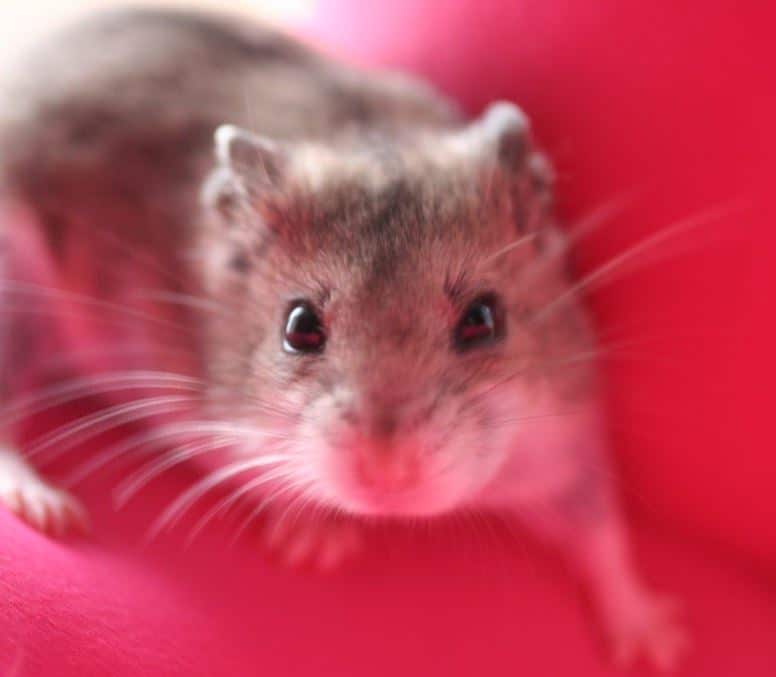
Chinese hamsters can be affectionate and good-natured, but they’re also quite shy. If you’ve handled them from a young age and they’re familiar with your touch they do not bite very often. However, if they’re scared or nervous then they can bite. To avoid scaring them, approach them slowly and gently.
Do make sure that you only hold your hamster not too far from the ground. They’re tiny animals and dropping them from even relatively low heights can do a lot of damage.
These hamsters will not bond with you the same way that a cat, a dog, or even a pet rat will, but they can get used to and appreciate your presence. Many Chinese hamsters come outside of hiding when they notice their favorite human is nearby, especially if you come bearing their favorite treats!
They’re also intelligent enough to be taught a few tricks and are not all that difficult to tame.
Chinese hamsters do not enjoy living with others. They’re solitary animals and will be territorial if other animals live in their cage. On very rare occasions they can live with a cage mate if they’re from the same litter, but this is not common at all.
An important thing to know about Chinese Hamsters is that they’re nocturnal. This means that they’re active during the night and sleep during the day. Because of this, they can sometimes be noisy at night.
Caring for Chinese Hamsters
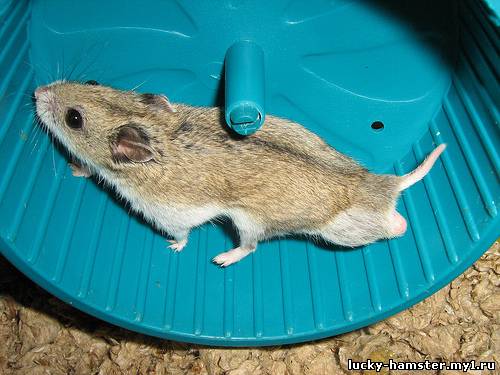
Caring for these little critters is not too difficult. They’re relatively low-maintenance and do not need a whole lot of special care. Nevertheless, there are some important things when it comes to their diet, housing, and grooming that you should know.
Diet of the Chinese Hamster🍎
Chinese hamsters thrive on a diet of commercial hamster pellets supplemented with grains, fruits, vegetables, timothy hay. In addition, since hamsters are omnivores, they can also eat the occasional piece of meat or fish.
As a general rule, about 80 to 90% of your hamster’s daily food intake should consist of pellets, as those are the most nutritionally complete food available for your hamster. The remaining 10% should primarily consist of fresh fruits and veggies while other foods should only be given as occasional treats.
Here are some foods that they like eating a lot and that are safe for them to have:
- Fruits: Apple, banana, blueberries, blackberries, cherries, figs
- Vegetables: Carrots, squash, cauliflower, broccoli, lettuce, spinach
- Fish: Salmon
- Meats: Turkey & Chicken
- Others: Walnuts, sunflower seeds
Of course, even though hamsters are omnivorous, there are certain foods that must be avoided:
- Apple Seeds ❌
- Onions ❌
- Hot peppers ❌
- Citrus fruits ❌
- Leafy parts of tomatoes ❌
- Garlic ❌
- Chocolate ❌
Housing a Chinese Hamster 🏡
All hamsters are very energetic and need enough space to stretch their legs. The minimum amount of space that a Chinese hamster needs is around 700 square inches of floor space, which is about 40 by 15 inches. The height of the cage should be a minimum of 24 inches, making the total minimum cage size 40 by 15 by 24 inches.
Of course, a bigger cage is always better. Hamsters enjoy having plenty of space to run around so you can’t go wrong buying a bigger cage.
One thing that’s important to take into account when buying a cage is bar spacing. The bar spacing should be big enough to allow your hamster to climb the cage but not too big to allow them to escape. The ideal bar spacing for a fully grown Chinese hamster is around a quarter of an inch.
Essential cage components
Of course, no hamster will feel at home in an empty cage. To make your Chinese hamster feel at home, they need the following components in their habitat:
- Exercise wheel
- Food dish and water bowl
- Hiding spots
- Chew toys
They will also need bedding of about 1 to 2 inches deep. Aspen shavings or paper-based bedding is often recommended because it’s cheap and versatile. Bedding material to avoid includes cedar shavings because they can cause irritation to your hamster.
Grooming a Chinese Hamster✂️
Chinese hamsters are very clean animals that spend a large part of the day cleaning themselves. Because of this, grooming them is not needed. They do not require regular baths. If you do notice that your furry friend is getting a little dirty simply clean them with a damp cloth.
The best thing you can do to help your hamster in the grooming process is to provide them with a clean cage. Fully clean their cage once a week for optimal results.
In addition, you can also provide them with a sand bath to help them in their grooming needs. Hamsters use sand baths to cleanse themselves of dirt and grease.
Lifespan of Chinese Hamsters
Chinese hamsters have an average lifespan of two to three years in captivity. Of course, their lifespan is highly dependent on luck, genetics, and the level of care they receive. Providing your furry friend with a healthy diet consisting of high-quality foods and regular vet checkups goes a long way in ensuring that your hamster lives as long as possible.
Common problems in Chinese Hamsters
Hamsters are pretty tough animals. They do not get sick very easily. However, there are some common ailments that they can suffer from:
- Wet tail. This is a condition that’s a result from bacteria and unsanitary living conditions or stress. According to Patton Vet Hospital: “This condition causes severe watery diarrhea which leads to matted, unkempt fur around the tail, loss of appetite, and dehydration.” If you notice these symptoms it’s essential that you take your hamster to the vet immediately for treatment because wet tail can be deadly.
- Overgrown teeth. Hamsters are rodents with teeth that never stop growing. Because of this, you need to make sure that they have access to chew toys that they can use to grind down their teeth. If they do not have access to chew toys their teeth can grow too long which can prevent them from eating.
Buying a Chinese Hamster
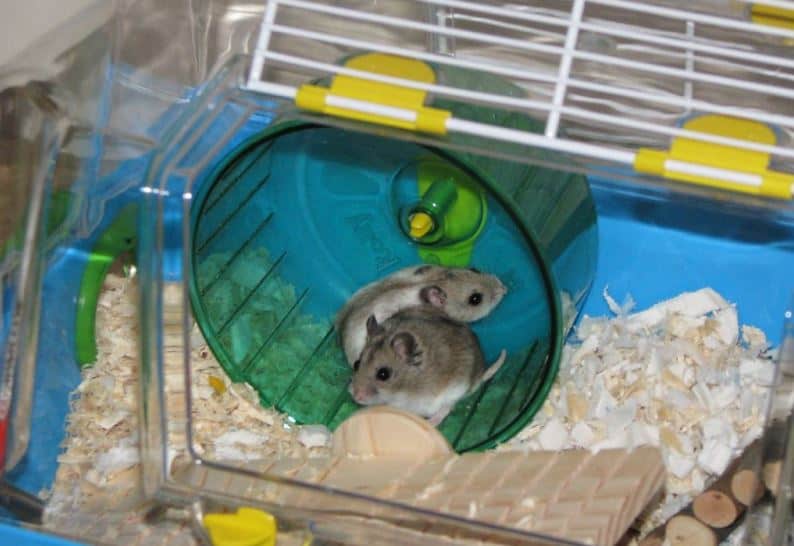
Chinese hamsters can be bought from pet stores or from breeders. On average, they cost about $15 to $20 from a pet store and between $30 to $40 from a breeder. Buying from a breeder is recommended over pet stores for a few reasons.
First, breeders typically take better care of the hamsters they sell than pet stores. While pet stores are primarily operating on a profit motive, many hamster breeders do it because they really love hamsters. Reputable breeders that take pride in their work take great care of the animals they sell and give them the best treatment possible. Secondly, the hamsters that are sold by breeders are often better socialized.
The only advantage of buying from a pet store is that it’s usually cheaper and more convenient. However, the hamster you buy from a breeder will likely be in better health which might save you money in vet bills down the line.
Frequently asked questions
Are Chinese Hamsters good pets?
Chinese hamsters can be good pets, but it depends on what you’re after. If you’re looking for a small pet that’s relatively low maintenance these hamsters can be a good fit. However, if you’re looking for a very affectionate pet, a Syrian hamster might be a better fit.
Are Chinese hamsters dwarfs?
No. Many people refer to them as dwarf hamsters but they’re technically not dwarf hamsters.
Final words
Chinese hamsters can be great pets if a low-maintenance, small rodent is what you’re looking for. They’re not the most affectionate of pets, but they can learn to get along and even appreciate their owners as long as you treat them with the love and respect they deserve.
Caring for them is not particularly difficult, they require a very straightforward diet, cage, and barely need any grooming. The only thing that might be a little challenging is taming them. Nevertheless, once you finally manage to tame them the end result can be quite rewarding and you’ll be friends for life.
If you’d like to learn more about hamsters, you might also be interested in the following breeds:
- How Long Do American Eskimo Dogs Live? Important Factors and Care Tips - September 29, 2023
- Do American Bulldogs Need Grooming? Essential Tips and Care Guidelines - September 29, 2023
- Do Bengal Cats Enjoy Playing? Essential Tips for Keeping Them Active - September 29, 2023